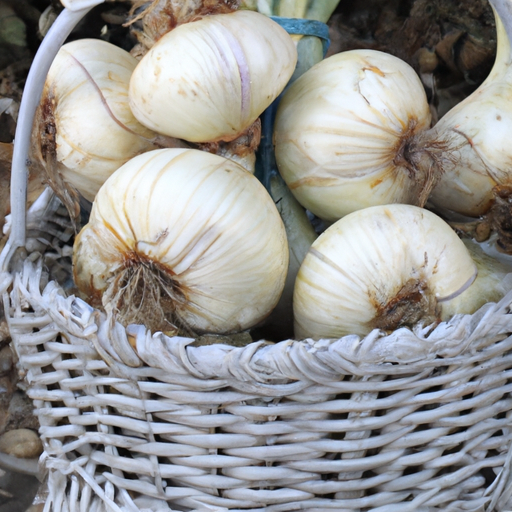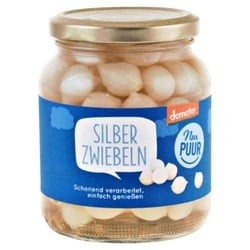In diesem Produkttest möchten wir die silberne Variante der Zwiebel, die Silberzwiebeln genannt wird, genauer unter die Lupe nehmen. Dabei werden wir uns mit ihren physischen Eigenschaften, kulinarischen Verwendungen, gesundheitlichen Vorteilen sowie den verschiedenen Arten von Silberzwiebeln und deren Anbaumethoden befassen. Darüber hinaus werden wir eine Bestenliste der besten Silberzwiebelprodukte zusammenstellen und Testkriterien vorstellen, anhand derer Verbraucher die Qualität von Silberzwiebeln bewerten können.
Silberzwiebeln Bestenliste
- Ein Stück Natur aud den Tisch: Durch die Verwendung von Qualitätszwiebeln und eine sorgfältige Verarbeitung schmeckt eingelegten Silberzwiebeln wie selbstgemacht
- Einfach Lecker: Eine leckere und gesunde Beilage für Kinder und Erwachsene, Natürlich und aromatisch dank der erstklassigen Silberzwiebeln
- Für würzigen Geschmack: Die Silberzwiebeln können durch mild würzigen Geschmack als Beilage zu pikanten Gerichten oder für einen Salat genutzt werden
- Gesund & Vitaminreich: tegut... verzichtet bewusst auf Geschmacksverstärker, Hefeextrakt, Süßungsmittel, gehärtete Fette und Farbstoffe, für einen guten und frischen Geschmack direkt aus dem Gemüse
- Ohne Aromen
- Kühne Silberzwiebeln in pikantem Aufguss
- knackig-würzigen silberzwiebeln sind in einem pikantem Aufguss eingelegt
- Sie eignen sich hervorragend als Beilage zur Brotzeit, zum Raclette oder als Alternative zu frischen Zwiebeln.
- Lieferumfang: 6er Pack (6x330g Glas)
- + usy Block: Genussmensch
Introduction
Silberzwiebeln, also known as silver onions or pickling onions, are a type of small onion that originated in Europe. They have been cultivated for centuries and were once a popular food among Roman soldiers.
Silberzwiebeln have a slightly sweet and tangy taste and are commonly pickled or used in salads, sandwiches, and stews. They are also a good source of vitamin C, fiber, and antioxidants, making them a nutritious addition to any meal.
In addition to their culinary uses, silberzwiebeln have also been used for medicinal purposes in traditional medicine. They have been said to have anti-inflammatory and antibacterial properties, aiding in digestion, and even improving respiratory health.
Overall, silberzwiebeln are a versatile and flavorful ingredient that provide numerous health benefits. Whether eaten raw or cooked, they are a great addition to any diet.
– Brief history and origin of silberzwiebeln

– Silberzwiebeln haben ihren Ursprung in der Türkei und werden seit Jahrhunderten in Europa angebaut.
– Die ersten Erwähnungen von Silberzwiebeln stammen aus dem 16. Jahrhundert in französischen und deutschen Schriften.
– Sie erhielten ihren Namen wegen ihres silbernen Hauthüllblattes, das die Zwiebel umgibt.
– Overview of silberzwiebeln’s taste and nutritional benefits
– Silberzwiebeln have a slightly sweet and tart taste, with a mild onion flavor.
– They are a good source of vitamin C, fiber, and antioxidants.
– Silberzwiebeln also contain small amounts of calcium, iron, and potassium.
– Due to their high content of quercetin, a flavonoid antioxidant, silberzwiebeln may help reduce inflammation and improve heart health.
– They are also low in calories, making them a great addition to a healthy diet.
Silberzwiebeln – weitere Empfehlungen
Physical Characteristics
Size, Shape and Color of Silberzwiebeln:
Silberzwiebeln, also known as silver onions, are small, round bulbs that resemble miniature onions. They typically range in size from one to three centimeters in diameter and are usually sold pickled in glass jars.
Silberzwiebeln have a distinct pale yellow to white color, with a smooth and shiny outer skin. When cut open, they reveal layers of white flesh, similar to regular onions. Overall, their size, shape, and color make them a unique and versatile ingredient in a variety of dishes.
Differences Between Silberzwiebeln and Regular Onions:
While silberzwiebeln may resemble regular onions in physical appearance, there are several notable differences between the two. For starters, silberzwiebeln are much smaller in size than regular onions.
Additionally, silberzwiebeln have a milder flavor compared to regular onions, making them a popular ingredient in pickled and preserved dishes. They also have a sweeter taste and firmer texture, which makes them a great garnish or addition to salads and sandwiches.
Another difference between silberzwiebeln and regular onions is that silberzwiebeln are typically pickled or preserved, while regular onions are usually used fresh in cooking. This means that silberzwiebeln have a longer shelf life and can be stored for several months in a cool and dry pantry.
– Size, shape and color of silberzwiebeln
Silberzwiebeln, also known as silver onions or pearl onions, are small, round onions that are typically between 1 and 2 centimeters in diameter. They have a distinctive white or silvery skin that easily peels away to reveal a translucent, white flesh inside.
Unlike regular onions, silberzwiebeln are not typically used as a primary ingredient in a recipe but rather as a flavoring agent or garnish due to their small size. They have a milder and sweeter flavor than regular onions, which makes them perfect for pickling, roasting, or sautéing.
In terms of color, silberzwiebeln are typically white or pale yellow, with a shiny and smooth exterior. Some varieties may have a slight pink or purple tinge to their skin. Overall, their small size and distinctive color make them a visually appealing addition to any dish.
Silberzwiebeln – die Besten im Test
– Differences between silberzwiebeln and regular onions
– In terms of appearance, silberzwiebeln are smaller and rounder than regular onions.
– Silberzwiebeln have a slightly sweeter taste compared to regular onions.
– Silberzwiebeln also have a milder and less pungent aroma than regular onions.
Culinary Uses
How silberzwiebeln are typically prepared and eaten:
Silberzwiebeln can be enjoyed in various ways, depending on personal taste preferences. Some people enjoy eating them raw as a snack or adding them to salads for a crunchy texture and slightly sweet flavor. Silberzwiebeln can also be pickled to preserve their freshness and tangy taste.
In cooking, silberzwiebeln are often used as a flavoring ingredient and added to various recipes. They can be sliced and used as a topping for burgers, sandwiches, and pizzas. Additionally, silberzwiebeln can be sautéed with other vegetables, added to stews, soups, or casseroles to add a sweet and savory flavor.
Popular dishes that incorporate silberzwiebeln:
1. German Bratwurst: Silberzwiebeln are often used as a popular topping for German sausages, particularly bratwurst. The pickled onions add a tangy, acidic flavor to complement the savory sausage.
2. Mediterranean Salads: Silberzwiebeln can also be found in various Mediterranean salads, often paired with feta cheese, olives, and other vegetables. The sweet flavor of silberzwiebeln creates a perfect balance with the saltiness of the other ingredients.
3. Thai Stir-Fry: Silberzwiebeln can be a great addition to Thai stir-fries, adding texture and a slightly sweet flavor to the dish. They can be sautéed alongside other vegetables like bell peppers and zucchini.
Overall, silberzwiebeln are versatile in their uses and add a touch of sweetness and tanginess to various dishes.
– How silberzwiebeln are typically prepared and eaten
Silberzwiebeln, also known as silver skin onions or pickling onions, are typically eaten in pickled form. They are often used in pickles, chutneys, relishes, and salads. The silberzwiebeln’s small size and mild flavor make them a popular ingredient in various dishes. They can be served as a garnish for cocktails or as a topping for sandwiches, burgers, and hot dogs.
Silberzwiebeln pickled in vinegar and spices are a common accompaniment to cold meats and cheeses. They are also a popular addition to cheese and charcuterie boards. When served with oily fish such as mackerel or herring, the slight acidity of the silberzwiebeln cuts through the richness of the fish.
Some cuisines use silberzwiebeln in their traditional dishes. In Germany, pickled silberzwiebeln are served with meat dishes, especially pork. In Italy, they are often added to Sicilian caponata, a traditional sweet and sour dish of eggplants, celery, tomatoes, and capers. Pickled silberzwiebeln are also used in Scandinavian cuisine, where they are traditionally served with meatballs and mashed potatoes or alongside dishes with pickled herring.
In summary, silberzwiebeln are most commonly pickled and used as a versatile ingredient in various dishes, especially as a condiment or flavor enhancer.
– Popular dishes that incorporate silberzwiebeln
- Silberzwiebeln werden oft in eingelegter Form als Beilage zu Fleischgerichten serviert.
- Sie sind auch eine beliebte Zutat in Salaten und Sandwiches.
- In der deutschen Küche werden sie oft in Eintöpfen und Suppen verwendet.
- In anderen Ländern werden sie auch in currys, chutneys und salsas eingesetzt.
Health Benefits
Silberzwiebeln are highly nutritious and offer a range of health benefits. They are a good source of vitamin C, which is important for a healthy immune system and can help to enhance the absorption of iron from plant-based foods. Silberzwiebeln are also high in antioxidants, which help to protect the body against harmful free radicals and may reduce the risk of certain chronic diseases.
In addition, silberzwiebeln are a good source of dietary fiber, which is important for digestive health and can help to reduce the risk of conditions such as constipation, hemorrhoids, and diverticulitis. Silberzwiebeln also contain a range of minerals, including potassium, calcium, and magnesium, which are important for healthy bones, muscles, and nerve function.
Overall, incorporating silberzwiebeln into your diet can help to boost your overall health and wellbeing, providing a range of essential vitamins, minerals, and antioxidants in a tasty and versatile package.
– Nutritional value of silberzwiebeln
Silberzwiebeln are known for their impressive array of health benefits. They are a rich source of vitamins, minerals, and antioxidants. Silberzwiebeln are particularly high in vitamin C, which is important for a strong immune system and healthy skin. They also contain significant amounts of vitamin B6, which is crucial for brain function and the production of red blood cells.
Silberzwiebeln are also an excellent source of minerals such as iron, calcium, and potassium. Iron is essential for the formation of red blood cells and transporting oxygen around the body. Calcium is vital for maintaining strong bones and teeth, while potassium helps regulate blood pressure and the fluid balance in the body.
In addition to vitamins and minerals, silberzwiebeln are also rich in antioxidants, which protect the body against oxidative stress and may reduce the risk of chronic diseases such as cancer and heart disease. They also contain quercetin, a flavonoid that has anti-inflammatory properties and may help alleviate symptoms of allergies and asthma.
Overall, the nutritional value of silberzwiebeln makes them a valuable addition to any diet, providing a wide range of essential vitamins, minerals, and antioxidants.
– How silberzwiebeln may contribute to overall health and wellbeing
Silberzwiebeln offer a range of health benefits and can contribute to overall health and wellbeing. They are low in calories and high in dietary fiber, making them an excellent addition to a healthy diet. They also contain essential vitamins and minerals like vitamin C, potassium, and calcium.
Silberzwiebeln are known for their anti-inflammatory properties and antioxidants, both of which can help reduce the risk of chronic diseases like cancer, heart disease, and arthritis. The sulfur-containing compounds in silberzwiebeln may also offer protection against certain types of cancer.
Consuming silberzwiebeln can also help regulate blood sugar levels due to their low glycemic index, making them an excellent choice for people with diabetes or individuals trying to manage their blood sugar levels.
Overall, silberzwiebeln offer an array of health benefits that make them a great addition to any diet. They are easy to incorporate into meals, and their unique flavor and texture can enhance the taste of many dishes.
Types of Silberzwiebeln
– Different varieties of silberzwiebeln and their unique characteristics
- There are different varieties of silberzwiebeln with unique characteristics.
- Some varieties may have a milder or sweeter flavor than others.
- Other varieties may have a more intense flavor and aroma.
- The size and shape of the silberzwiebeln may also vary depending on the variety.
- Some varieties may be better suited for certain culinary applications, such as pickling or roasting.
– Uses for different types of silberzwiebeln
There are several different types of silberzwiebeln, and each has its own unique flavor profile and culinary uses. Here are some of the most popular varieties and their uses:
1. White silberzwiebeln: These are the most common variety of silberzwiebeln and are typically used in salads, sandwiches or as a garnish. They have a mild, sweet and tangy flavor that complements many different dishes.
2. Red silberzwiebeln: These are slightly sweeter than white silberzwiebeln and have a more intense flavor. They are commonly used in pickling and as a topping for burgers or sandwiches.
3. Golden silberzwiebeln: These have a mild and sweet flavor, and are often used in stir-frys and other Asian-inspired dishes.
4. Giant silberzwiebeln: These silberzwiebeln are much larger than the other varieties and have a milder, sweeter flavor. They are often used in stews, soups or roasted as a side dish.
Regardless of the variety, silberzwiebeln are a versatile ingredient that can be used in a variety of dishes to add flavor and texture. They can be sautéed, roasted, pickled or eaten raw, making them a valuable addition to any kitchen.
Growing Silberzwiebeln
Wenn es darum geht, Silberzwiebeln anzubauen, gibt es ein paar wichtige Tipps zu beachten. Hier sind einige der wichtigsten:
1. Auswahl des Standorts: Silberzwiebeln bevorzugen einen sonnigen Standort mit gut durchlässigem Boden. Es ist wichtig, einen Bereich auszuwählen, der nicht zu nass ist, da zu viel Feuchtigkeit das Wachstum beeinträchtigen kann.
2. Bodenvorbereitung: Bevor man Silberzwiebeln pflanzt, sollte der Boden gut vorbereitet sein. Das bedeutet, dass man ihn lockern und mit Kompost oder Dünger anreichern sollte, um sicherzustellen, dass die Zwiebeln die Nährstoffe bekommen, die sie brauchen.
3. Pflanzenzeitpunkt: Die beste Zeit, um Silberzwiebeln zu pflanzen, ist im Frühjahr oder Herbst. Es ist wichtig, darauf zu achten, dass der Boden bereits aufgewärmt ist, bevor man die Zwiebeln pflanzt.
4. Pflanztiefe: Silberzwiebeln sollten etwa 2-3 cm tief in den Boden gepflanzt werden. Es ist auch wichtig, die Zwiebeln mit genügend Platz zu pflanzen, damit sie sich gut entwickeln können.
5. Bewässerung: Es ist wichtig, die Silberzwiebeln gleichmäßig zu bewässern, insbesondere während der Wachstumsphase. Es empfiehlt sich, die Pflanzen mit einer Gießkanne zu bewässern, um sicherzustellen, dass sie ausreichend Wasser erhalten.
6. Düngung: Es ist ratsam, die Silberzwiebeln während des Wachstums mit einem stickstoffhaltigen Dünger zu versorgen, um sicherzustellen, dass sie genügend Nährstoffe bekommen.
Wenn man diese Tipps befolgt, kann man sicherstellen, dass die Silberzwiebeln gut wachsen und gesund bleiben. Es lohnt sich, ein paar von ihnen im Garten anzubauen, da sie eine wertvolle Ergänzung zu jeder Küche darstellen.
– Tips for planting and maintaining silberzwiebeln
– Für eine erfolgreiche Pflanzung von Silberzwiebeln sollten die Zwiebeln im Frühjahr in lockerem und feuchtem Boden gepflanzt werden.
– Es ist wichtig, dass genügend Abstand zwischen den Zwiebeln eingehalten wird, um Schimmelbildung zu vermeiden. Ein Abstand von 10 bis 15 Zentimetern ist empfohlen.
– Silberzwiebeln benötigen regelmäßige Bewässerung, aber Staunässe sollte vermieden werden. Eine Mulchschicht kann helfen, die Feuchtigkeit im Boden zu halten.
– Um eine optimale Entwicklung zu fördern, ist es ratsam, alle paar Wochen eine Düngung vorzunehmen.
– Silberzwiebeln können gut in Töpfen oder in kleinen Gärten angebaut werden, da sie nicht viel Platz benötigen.
– Das Entfernen von Unkraut und das Lockern des Bodens um die Zwiebeln herum ist wichtig, um Schädlinge fernzuhalten und das Wachstum der Pflanze zu fördern.
– Best conditions for growing silberzwiebeln
- Best conditions for growing silberzwiebeln:
– Silberzwiebeln prefer well-draining soil with a pH between 6.0 and 6.5.
– They should be planted in a location with full sun exposure.
– Silberzwiebeln can be grown in containers or raised beds as well as in traditional garden beds.
– They should be planted in the spring and harvested in the summer or fall.
– Adequate watering and regular fertilization can help produce a larger crop of silberzwiebeln.
Conclusion
– Recap of silberzwiebeln’s physical characteristics, culinary uses, health benefits, and growing tips
– Final thoughts on why silberzwiebeln are a valuable addition to any kitchen or garden.
– Recap of silberzwiebeln’s physical characteristics, culinary uses, health benefits, and growing tips
Recap:
– Silberzwiebeln are small, white onions with a slightly sweet and tangy taste.
– They are low in calories and high in vitamin C and antioxidants, making them a nutritious addition to any diet.
– Silberzwiebeln can be used raw in salads or pickled as a condiment for sandwiches and burgers.
– They are also commonly used in German and Scandinavian cuisine, such as in stews, roasts, and sausages.
– Silberzwiebeln are easy to grow in gardens or containers, and prefer well-draining soil and full sun.
– They can be planted in early spring or late summer, and harvested within 80-100 days.
Overall, silberzwiebeln are a versatile and healthy ingredient that can add flavor and nutrition to a wide variety of dishes. Whether you use them raw or cooked, pickled or roasted, they are sure to enhance your meals with their unique taste and texture. By following the growing tips, you can even cultivate your own supply of silberzwiebeln, and enjoy their benefits year-round.
– Final thoughts on why silberzwiebeln are a valuable addition to any kitchen or garden.
In conclusion, Silberzwiebeln may be an underrated gem in the culinary world, but they are a valuable addition to any kitchen or garden. Their unique taste and texture make them perfect for a variety of dishes, and their health benefits are undeniable. Whether you are looking to boost your immune system or add some flavor to your meals, silberzwiebeln are versatile and beneficial. Additionally, growing silberzwiebeln is relatively easy and can even be done in containers for those with limited garden space. Overall, adding silberzwiebeln to your diet and garden can be a fantastic way to expand your culinary horizons and improve your overall health and wellbeing.
Ähnliche Artikel & Informationen
Schon einmal von veganem Hack gehört? Dieses Produkt wird aus Hülsenfrüchten wie Borlotti-Bohnen oder Wachtelbohnen hergestellt und ist eine tolle Alternative zu Fleischhack. Es eignet sich perfekt als Füllung für gefüllte Paprika oder als Belag für eine vegane Pizza. Um den Geschmack abzurunden, kann man zum Beispiel getrocknete Tomaten in Öl, Kapernäpfel oder Grüne Oliven hinzufügen. Auch Borettane-Zwiebeln eignen sich gut für diese Gerichte. Beluga-Linsen sind ebenfalls eine super Wahl, um vegane Gerichte aufzupeppen. Sie haben eine hübsche schwarze Farbe und passen gut in Suppen und Eintöpfe. Für diejenigen, die gerne etwas Exotisches ausprobieren möchten, lohnt es sich, einmal Jackfruit auszuprobieren. Sie hat eine angenehme zarte Konsistenz und kann als Fleischalternative in vielen Gerichten eingesetzt werden. Wenn man ein einfaches Tomatensugo zubereiten möchte, kann man es mit ein bisschen Tomatenmark verfeinern. Das verleiht dem Sugo noch mehr Geschmack.
Letzte Aktualisierung am 2024-11-21 / Affiliate Links / Bilder von der Amazon Product Advertising API















